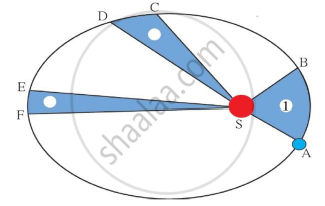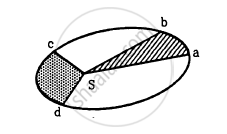Advertisements
Advertisements
प्रश्न
What is the direction of areal velocity of the earth around the sun?
उत्तर
Areal velocity of the earth around the sun is given by `(dA)/(dt) = L/(2m)` where L is the angular momentum and m is the mass of the earth.
But angular momentum `L = r xx p = r xx mv`
∴ Areal velocity `((dA)/(dt)) = 1/(2m) (r xx mv) = 1/2 (r xx v)`
Therefore, the direction of areal velocity `((dA)/(dt))` is the direction of `(r xx v)`, i.e., perpendicular to the plane containing r and v and directed as given by the right-hand rule.
APPEARS IN
संबंधित प्रश्न
A Saturn year is 29.5 times the earth year. How far is the Saturn from the sun if the earth is 1.50 ×108 km away from the sun?
Identify the law shown in the figure and state three respective laws.

In the Following figure shows the elliptical path of a planet about the sun. The two shaded parts have equal area. If t1 and t2 be the time taken by the planet to go from a to b and from c to d respectively,

The orbit of a planet revolving around a star is _______.
State Kepler’s laws.
The mass and radius of earth is 'Me' and 'Re' respectively and that of moon is 'Mm' and 'Rm' respectively. The distance between the centre of the earth and that of moon is 'D'. The minimum speed required for a body (mass 'm') to project from a point midway between their centres to escape to infinity is ______.
To verify Kepler's third law graphically four students plotted graphs. Student A plotted a graph of T (period of revolution of planets) versus r (average distance of planets from the sun) and found the plot is straight line with slope 1.85. Student B plotted a graph of T2 v/s r3 and found the plot is straight line with slope 1.39 and negative Y-intercept. Student C plotted graph of log T v/s log r and found the plot is straight line with slope 1.5. Student D plotted graph of log T v/s log r and found the plot is straight line with slope 0.67 and with negative X-intercept. The correct graph is of student
In our solar system, the inter-planetary region has chunks of matter (much smaller in size compared to planets) called asteroids. They ______.
If the sun and the planets carried huge amounts of opposite charges ______.
- all three of Kepler’s laws would still be valid.
- only the third law will be valid.
- the second law will not change.
- the first law will still be valid.
lf the angular momentum of a planet of mass m, moving around the Sun in a circular orbit is L, about the center of the Sun, and its areal velocity is ______.
